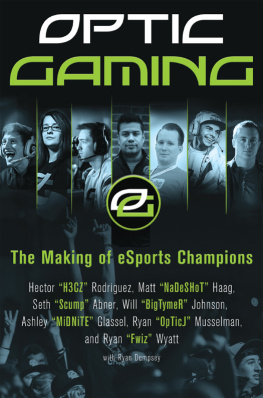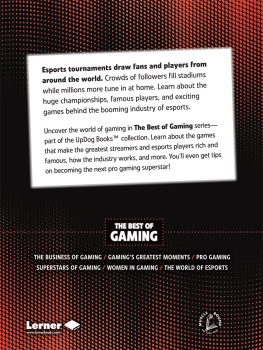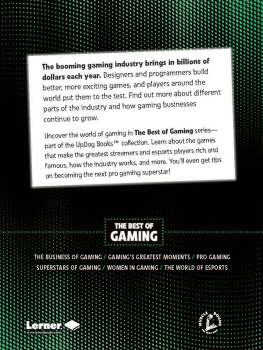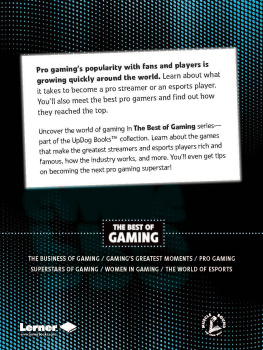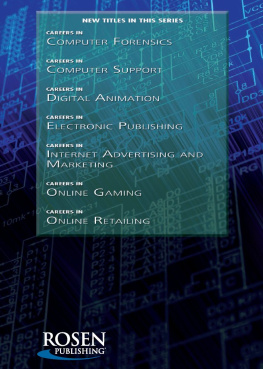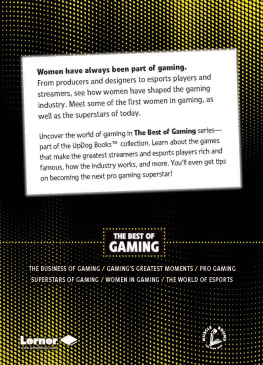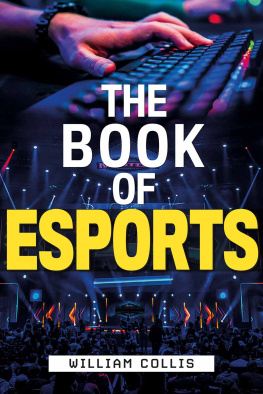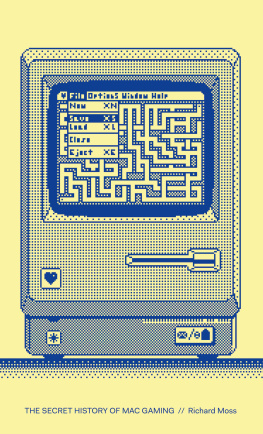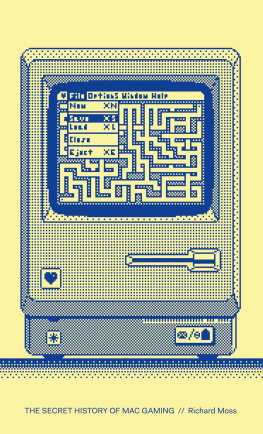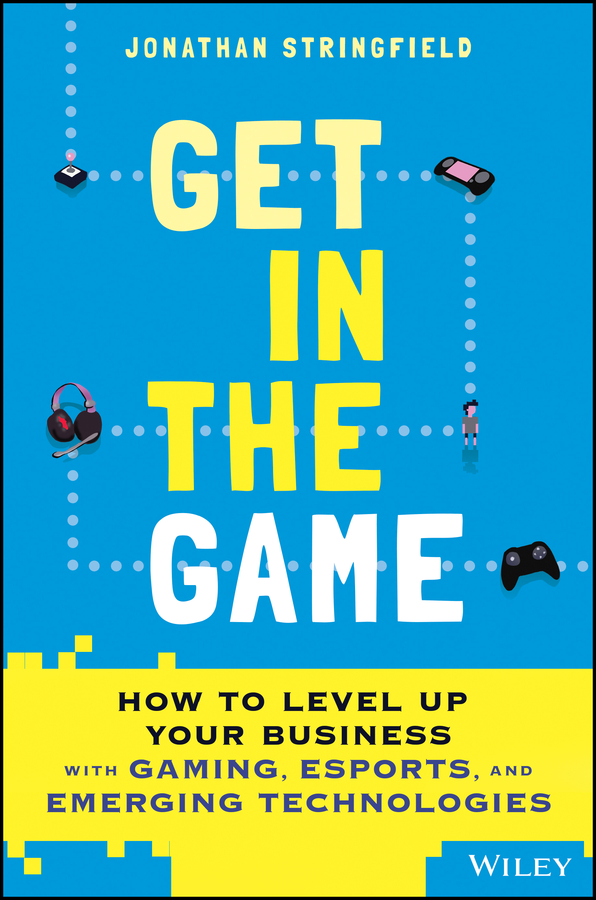
Table of Contents
List of Tables
- Chapter 5
- Chapter 9
Guide
Pages
JONATHAN STRINGFIELD
GET IN THE GAME
HOW TO LEVEL UP YOUR BUSINESS WITH GAMING, ESPORTS, AND EMERGING TECHNOLOGIES

Copyright 2022 by John Wiley & Sons, Inc. All rights reserved.
Published by John Wiley & Sons, Inc., Hoboken, New Jersey.
Published simultaneously in Canada.
No part of this publication may be reproduced, stored in a retrieval system, or transmitted in any form or by any means, electronic, mechanical, photocopying, recording, scanning, or otherwise, except as permitted under Section 107 or 108 of the 1976 United States Copyright Act, without either the prior written permission of the Publisher, or authorization through payment of the appropriate percopy fee to the Copyright Clearance Center, Inc., 222 Rosewood Drive, Danvers, MA 01923, (978) 7508400, fax (978) 6468600, or on the Web at www.copyright.com. Requests to the Publisher for permission should be addressed to the Permissions Department, John Wiley & Sons, Inc., 111 River Street, Hoboken, NJ 07030, (201) 7486011, fax (201) 7486008, or online at http://www.wiley.com/go/permissions.
Limit of Liability/Disclaimer of Warranty: While the publisher and author have used their best efforts in preparing this book, they make no representations or warranties with respect to the accuracy or completeness of the contents of this book and specifically disclaim any implied warranties of merchantability or fitness for a particular purpose. No warranty may be created or extended by sales representatives or written sales materials. The advice and strategies contained herein may not be suitable for your situation. You should consult with a professional where appropriate. Neither the publisher nor author shall be liable for any loss of profit or any other commercial damages, including but not limited to special, incidental, consequential, or other damages.
For general information on our other products and services or for technical support, please contact our Customer Care Department within the United States at (800) 7622974, outside the United States at (317) 5723993 or fax (317) 5724002.
Wiley publishes in a variety of print and electronic formats and by printondemand. Some material included with standard print versions of this book may not be included in ebooks or in printondemand. If this book refers to media such as a CD or DVD that is not included in the version you purchased, you may download this material at http://booksupport.wiley.com. For more information about Wiley products, visit www.wiley.com.
Library of Congress CataloginginPublication Data is Available:
ISBN 9781119855361 (Hardback)
ISBN 9781119855385 (ePDF)
ISBN 9781119855378 (ePub)
COVER ART & DESIGN: PAUL McCARTHY
This book is dedicated to my mom, Lee Stringfield, who encouraged my love of gaming and writing throughout my life. I think she would be proud of the result.
Preface: The Revolution of 1972
The year 1972 not only irrevocably changed the consumer entertainment ecosystem, but also set into motion events that continue to fundamentally alter the ways in which humans interrelate via media. More specifically, two distinct but related phenomena were occurring in the world.
First, the Magnavox Odyssey was released, which is widely considered to be the first home gaming console. The home console shifted the center of gravity for video games from the arcade to the home. Though the transition period would be tumultuous, including a crash that nearly capsized the entire industry less than a decade away, interactive entertainment had found a home in living rooms across the globe by merit of being an accessory to existing home technology (it connected to a standard television set) rather than requiring a separate (and expensive) monitor. In one sense, 1972 is the year that video games shifted from being occasion and geographicbounded entertainment to personal, accessible, and scaledattributes that would paint the success of the industry for decades to come.
Second, beyond the living room and within the venerated halls of Stanford University, the first digital gaming competition was being held. A tournament around the earlycomputer gaming favorite Spacewar! was being held at the artificial intelligence lab, complete with multiple competitors and a valuable prize (a yearlong subscription to Rolling Stone). In a similar parallel to home consoles, this was the beginning of a tumultuous history, inclusive of a nearexistential industry crash all its own. Thus, in another sense, 1972 is also the year in which the nowglobal phenomenon of esports was born.
As far as technological and cultural revolutions go (and I'll argue that we'll be addressing a bit of both), 1972 is a pivotal year. The commonality between these events was that interactive entertainment had come to roost (albeit in different legacies reflected in modern times). It also represents a rare opportunity where the occasionally confusing and not always welldocumented history of gaming and esports intersect in a meaningful way within a single year. Here we find one of our first major problems when discussing gamingthe industry is multifaceted, expansive, manifest in a number of forms, and carries a long history that speaks to the powerful intersection of technology and creativity.
And yet, to the uninitiated or unaware, you'd never know that was the case. For too long, gaming has been considered a monolithic entity that amounts to little more than the frivolous pastime of children. Fastforward to today, and the reality is that gaming represents a global, multibilliondollar ecosystem within which about one in every three humans on the planet is a participant, and is positioned to shape the contours of our relationship with technology for years to come. Despite the scale and influence of this sector, it has become abundantly clear that there is a significant knowledge gap between business decision makers and an industry that, in fairness, has a reputation for being extremely cloistered. Unfortunately, this gap is quickly transitioning from a curiosity to a strategic blind spot for businesses across nearly every industry as the influence of gaming and gamingrelated concepts begin to shape technologies as fundamental as the internet.
Character Sheet: Approach and Intended Audience of This Book
For business decision makers and marketers, those who know that gaming is important but haven't yet figured out their point of view, an understanding of the gaming ecosystem and knowing how to integrate with it beyond the superficial is set to become one of the most important tool kits in modern business. While there are many ways a person or organization can enter the expansive gaming ecosystem, understanding and aligning on the right strategic fit, including the proper historical background and a deep understanding of consumer psychology and need states around these media, will define the most successful integrations. In addition, having a perspective on common business concerns related to brand safety and toxicity within the gaming community, including the genesis of these (occasionally overblown) concerns from societal and cultural orientations towards gaming, will balance fact from fiction in evaluating potential opportunities.
Parents seeking to understand what is likely occupying the majority of their children's leisure time may also find value in learning more about the history, landscape, and benefits of gaming in a broader context. Although interest in gaming is not a demarcation between adults and children (given that fans of gaming are not predominately children), there are indeed some generational divides. Despite differences in how one might be exposed to gaming or why one might wish to learn more from a personal or professional standpoint, the most hyperbolic claim I'll make is that nearly everyone stands to gain something from a deeper understanding of gaming as the proliferation of this ecosystem is inevitable. It is massive, bigbudget entertainment that lives on an increasing array of devices. It is shaping or creating new economies.
Next page

